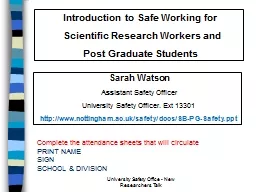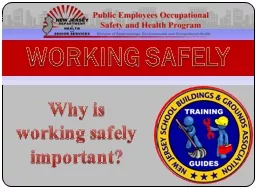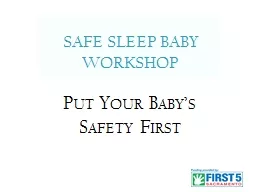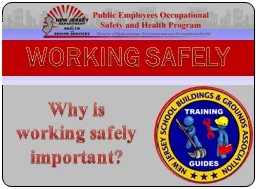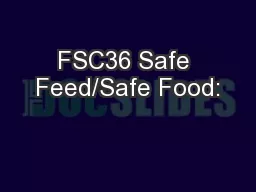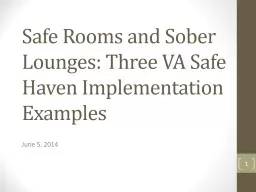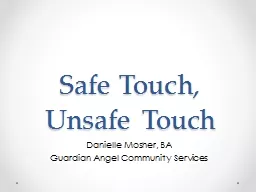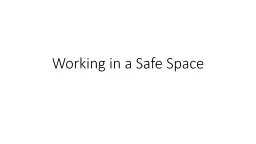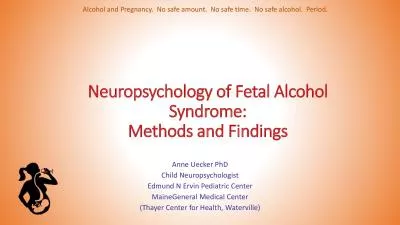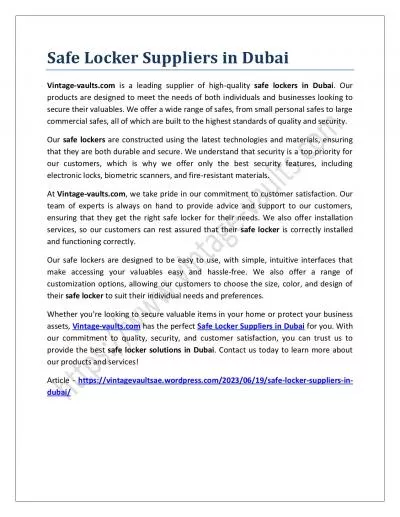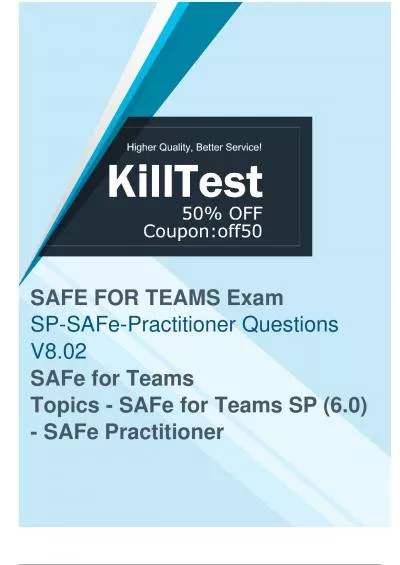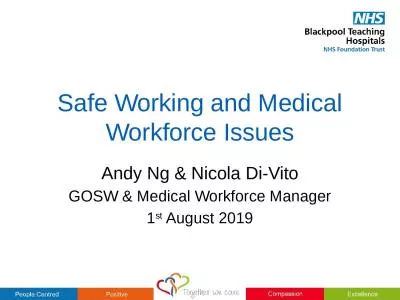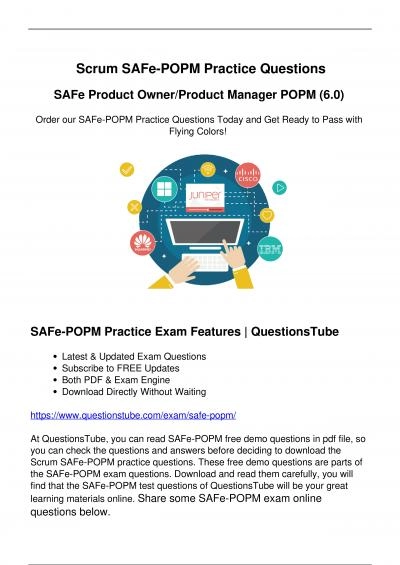PPT-Introduction to Safe Working for
Author : conchita-marotz | Published Date : 2016-12-14
Scientific Research Workers and Post Graduate Students Sarah Watson Assistant Safety Officer University Safety Officer Ext 13301 httpwwwnottinghamacuksafetydocsSBPGSafetyppt
Presentation Embed Code
Download Presentation
Download Presentation The PPT/PDF document "Introduction to Safe Working for" is the property of its rightful owner. Permission is granted to download and print the materials on this website for personal, non-commercial use only, and to display it on your personal computer provided you do not modify the materials and that you retain all copyright notices contained in the materials. By downloading content from our website, you accept the terms of this agreement.
Introduction to Safe Working for: Transcript
Scientific Research Workers and Post Graduate Students Sarah Watson Assistant Safety Officer University Safety Officer Ext 13301 httpwwwnottinghamacuksafetydocsSBPGSafetyppt Complete the attendance sheets that will circulate. Ohio Chapter, American Academy of Pediatrics Roundtable . Friday, April 4 . Christy Beeghly, MPH, . ODH Violence and Injury Prevention Program Administrator. Ohio Injury Prevention Partnership (OIPP) . Why is working safely. important? . How do you work safely?. Follow safety instructions. Wash your hands. Wear . PPP. YOU MUST,. Why is working safely important?. Simply put,. PEOPLE DON’T GET HURT!. WORKSHOP . 1. Put Your Baby’s . Safety First. PRE-SURVEY. 2. Please take a few minutes to . complete the pre-workshop survey.. What are Infant Sleep-Related Deaths?. Death of a baby under age of one who dies while sleeping.. Why is working safely. important? . How do you work safely?. Follow safety instructions. Wash your hands. Wear . PPP. YOU MUST,. Why is working safely important?. Simply put,. PEOPLE DON’T GET HURT!. Guidance Document Version 7.0 Training. June 2017. FSC36 Safe Feed/Safe Food . Training. AGENDA. Very Quick Review Food Safety Modernization Act. Guidance Document: . Old vs. New. Questions. Please ask Questions as we cover the information. . June 5, 2014. 1. Bay Pines VA/Boley Centers . Morningside Safe Room . Background . Safe Room Design. Safe Room Operations. Lessons Learned . Fred . Fearday. , LCSW. 2. Background. In 2006, Boley Centers opens its first Safe Haven and includes a Safe Room in the design of the building’s rehabilitation. . Work Safe Stay Safe Module 3 What You Will Learn How to work with and around forklifts safely How to lift safely How to safely exit the workplace How to protect yourself and others from accidents Safe Touch, Unsafe Touch Danielle Mosher, BA Guardian Angel Community Services Goals To teach students the difference between safe and unsafe touches To inform students of their private parts and that BEHAVIOR IS EVERYTHING!!!. You will put yourself on the line every time you perform in class, an audition or onstage. You will be exposing your personal self…. Training as an actor requires you to wake up your inner impulses and enter a role without barriers or emotional protection.. Alcohol and Pregnancy. No safe amount. No safe time. No safe alcohol. Period. Neuropsychology of Fetal Alcohol Syndrome: Methods and Findings Anne Uecker PhD Child Neuropsychologist Edmund N Vintage-vaults.com has the perfect Safe Locker Suppliers in Dubai for you. With our commitment to quality, security, and customer satisfaction, you can trust us to provide the best safe locker solutions in Dubai. Contact us today to learn more about our products and services! The SAFe for Teams SP (6.0) - SAFe Practitioner (SP-SAFe-Practitioner) is one of the industrial-recognized exams that has been inspiring beginners and seasonal professionals since its beginning. Now you can have the SP-SAFe-Practitioner practice test of Killtest to prepare for your exam well. The Scrum SP-SAFe-Practitioner practice test of Killtest is an ideal study material for good SP-SAFe-Practitioner exam preparation. Practice all the SP-SAFe-Practitioner exam questions and prepare you for the SP-SAFe-Practitioner exam quickly. #SP-SAFe-Practitioner #SP-SAFe-Practitioner Practice Test Andy Ng & Nicola . Di-Vito. GOSW & Medical Workforce Manager. 1. st. August. 2019. Medical Workforce Issues. Provision of . Rota. Templates and Induction Packs. Work with . Rota. Coordinators/Payroll. You are at the best place if you want to get prepared to ace your SAFe-POPM SAFe Product Owner/Product Manager POPM (6.0) certification test on your first attempt. We at QuestionsTube provide the latest SAFe-POPM exam questions in an effort to make sure you succeed. With our best SAFe-POPM exam questions and answers, we\'ve got you covered. Passing your Scaled Agile SAFe-POPM exam on the first attempt isn\'t just a dream; it\'s a reality with reliable and comprehensive SAFe-POPM exam questions. Let\'s explore how the SAFe-POPM exam questions can simplify your exam journey. #SAFe-POPM Exam Questions #QuestionsTube
Download Document
Here is the link to download the presentation.
"Introduction to Safe Working for"The content belongs to its owner. You may download and print it for personal use, without modification, and keep all copyright notices. By downloading, you agree to these terms.
Related Documents

